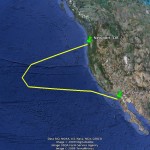
Seafloor mining continues to gain popularity in response to discoveries of diamond beds off Namibia and mineral deposits off Papua New Guinea and New Zealand. Today the Cape Business News announced another player bidding for these deep riches, the Cape Town based Marine and Mineral Projects. The company was responsible for the construction of the remote crawler used on the Peace in Africa, a De Beers Consolidated Mines owned ship that was converted into a floating diamond mine in a mammoth two year project. An example of a deep-sea crawler is shown above from Seascape Company. The full article is here.
Two particular points made in the article caught my attention, because I have seen the statements before in response to environmental concerns voiced here at DSN. The first point is that “deep-sea mining is less invasive than land based mining” because the deposits are literally sitting on the seafloor. The second point is that “the mining does disturb the seabed sediments and benthic communities, as most of the sediment resettles within minutes.”
I wonder if they mean 10 minutes or 10 hundred minutes. In my experience, these sediments can be very slow to settle, depending on the current regime. If currents are swift sediments could travel several hundred meters. Many of these benthic assemblages consist of suspension feeders and deposit feeders. These would be effected by sediment plumes, and I am afraid these effects have not been fully examined by biologists. Therefore, we cannot be sure that sea based mining is less invasive than terrestrial mining.
All in all, the boom in seafloor mining is a worrisome prospect because 1) some of the financial backers (e.g. Teck Cominco) have a poor environmental record on land and 2) environmental monitoring will be very difficult to carry out independently, without reliance on the mining companies and their technologies.






That thing looks like Montgomery Burns’ “Sea Cleaner”.
I cannot wait for the market to be flooded with sparkling perfect, artificial diamonds.
The fact that this is ‘out of sight, out of mind’ makes it even worse in terms of the general public knowing and/or caring about the negative effects.